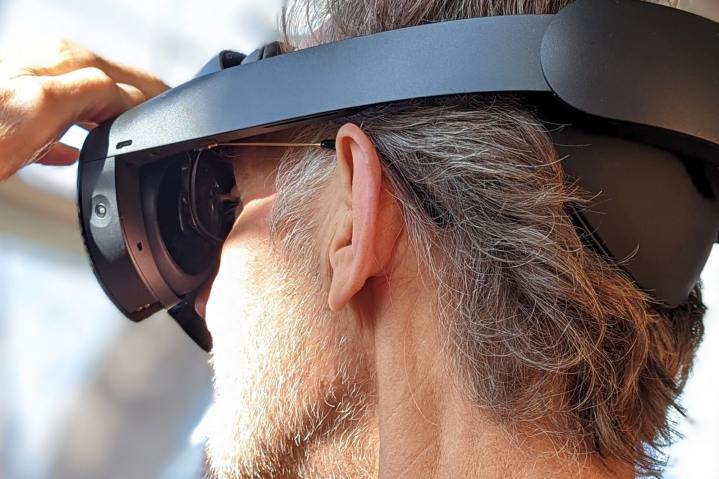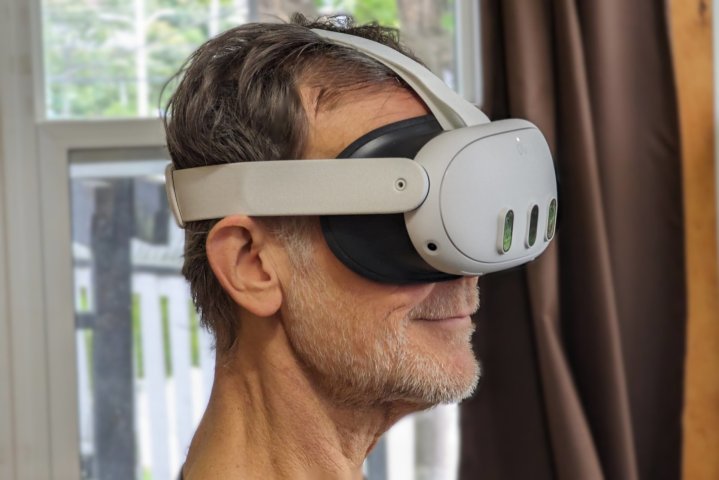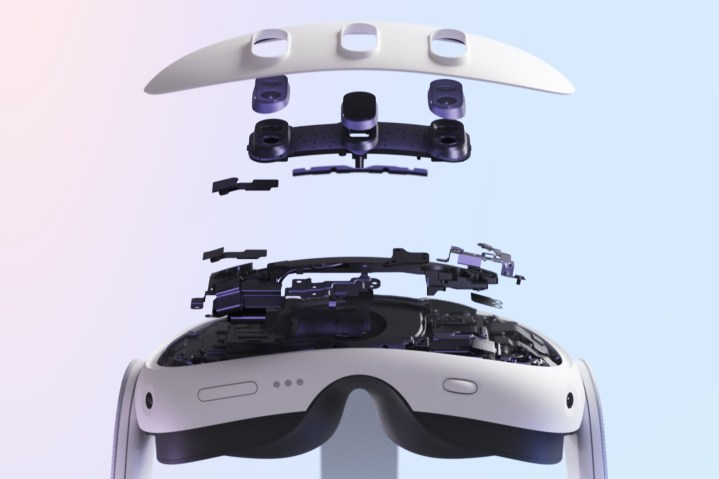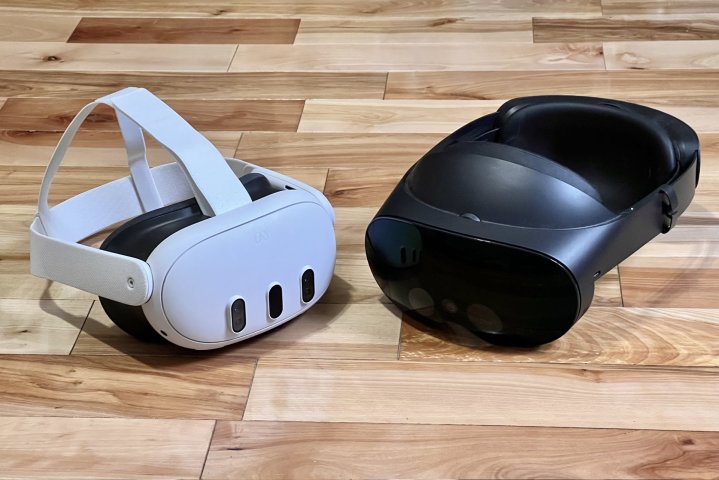Last year Meta released the Quest 3, a $500 VR headset that shares some features of the more expensive Quest Pro. If you’d like to explore virtual reality for games, entertainment, and work, there are several points to consider before making a decision between the Quest 3 and Quest Pro.
The operating system and app library are virtually the same. So we need to examine the price, performance, image quality, comfort, and special features to determine the best VR headset and help you identify which is right for your needs.
In many ways, the Meta Quest 3 is a game-changing VR headset that raises the bar for low-cost standalone solutions, as you can read in our Meta Quest 3 review. However, its design is closer to that of the Quest 2, while Meta introduced several new concepts in the Quest Pro (read our Meta Quest Pro review for more details).
Comfort
Comfort is sometimes overlooked in VR since there’s a tendency to think of the headset as technology, like a computer, tablet, or gaming console. In truth, it’s a wearable, so comfort is a critical factor in usability.
It might come as a surprise that the Meta Quest 3 is 207 grams lighter than a Quest Pro. Despite this fact, the Quest Pro will be more comfortable for most people.

The sides and bottom of the Quest Pro are open. Also, the battery is at the back of the headset, so the weight is more evenly distributed.
The Quest 3 has a full light shield and battery in the front. The slimmer profile and improved soft strap ease face pressure, and I found it comfortable for about an hour of gameplay, but my skin did get a bit irritated.
“VR face” is a common effect of spending an hour or more wearing a Quest 3. A red ring in the shape of the headset remains for quite some time after removing it. It’s more noticeable for some people than others, and accessory headbands often help alleviate this problem. If you have sensitive skin, the Quest 3 might put noticeable pressure on your face after an hour of use.

The Quest Pro’s design results in the display hovering in front of your eyes without pressure on your nose or cheeks. I can wear it for hours without discomfort. The downside is that the weight, balanced as it is, rests upon your forehead. It’s a bony area that can bear more weight, but some users find it uncomfortable.
The Quest Pro’s more open facial interface helps when working out in VR or playing intense games that might cause sweating and steaminess in a Quest 3. Most people consider the Quest Pro to be more comfortable overall. With either headset, it takes time to refine the fit, so allow a week or so to adjust to the headset you choose.
Performance
Devices designated as the pro model are usually faster, but that’s not always true when comparing different generations. The Quest Pro launched in October 2022, while Meta’s Quest 3 arrived a full year later.
In technology, even a few months can bring big changes. The Qualcomm XR2+ Gen 1 processor powering the Quest Pro was a step up from the Quest 2, but the Quest 3 is significantly faster with its Qualcomm XR2 Gen 2 chip.

Meta says the Quest 3 has twice the GPU performance of the Quest 2. The margin over the Quest Pro isn’t known, but it’s significant. Most games will target Quest 2 compatibility for another year or two, but there are several already taking advantage of the Quest 3’s improved graphics capability.
The Quest Pro has 50% more memory, 12GB versus the Quest 3’s 8GB. That could allow better multitasking and productivity, but I haven’t noticed that in my testing.
Image quality
Meta gave the Quest Pro a big boost in clarity by using pancake optics instead of the older Fresnel lenses of the Quest 2. The Quest 3 benefits from that research and also uses pancake lenses, which eliminate “god ray” artifacts and expand the sweet spot for better edge-to-edge clarity.

The Quest 3 has Meta’s highest-resolution display, with 30% more pixels and a slightly wider field of view than the Quest Pro. The Quest 3’s refresh rate can reach 120Hz, while the Quest Pro has a maximum of 90Hz.

However, the Quest Pro features mini-LED backlighting for deeper blacks and a higher dynamic range. For visual quality, it’s a matter of preference. Do you prefer a sharper image or better dynamic range? The Quest 3 delivers the former, while the Quest Pro offers the latter.
Mixed reality
One of the headline features of the Quest Pro, a color mixed-reality view that blends graphics into your physical environment, caught the attention of the media. Meta’s VR headset provided a convincing glimpse of what will be possible in AR glasses of the future.

While it’s interesting for demonstrations, few games and apps offered a compelling reason to use mixed reality. It’s fun to play a virtual board game on your table, but sometimes the experience is better in VR where your friends have faces, even if they look cartoonish.
AR might be a feature that works best as glasses when you’re moving around and looking for computer assistance in daily life. VR is meant to be immersive so you can lose yourself in another world.
For parents and pet owners, however, there’s a good reason to stay aware of your environment. Mixed reality games allow you to see what’s happening in the real world so you can avoid stepping on a cat or crashing into someone walking through your play space.

Whether or not you have a strong interest in mixed reality, the Quest 3 will outperform the Quest Pro in this area. The Quest 3 also includes a depth sensor to automatically map your room, while marking out a safe play area on the Quest Pro is a manual process.

Controllers and dock
The Quest Pro still has some exclusive features missing from the Quest 3. Eye-tracking and face-tracking are only possible with hardware built into the more expensive Meta headset.
The Quest Pro comes with a convenient charging dock to top up the battery the moment you set it aside. Plugging in a cable isn’t a big hassle, and the dock also simultaneously charges the controllers.

The Quest 3 uses AA batteries, so there could be times when your controllers die and you’re out of batteries. The Quest 3 controllers look similar to the Touch Pro controllers of the Quest Pro, but lack their precision tracking. The Quest 3’s cameras must see the controllers to track them, while the Touch Pro controllers are self-tracking.
Meta does sell a Quest 3 dock with rechargeable batteries for the Touch Plus controllers, but it adds $130 to the price.
Price
There are pros and cons for both headsets, but the Quest 3 is a newer device with better image quality and superior performance at a lower price. For $500, it’s hard to go wrong with a 128GB Meta Quest 3.
However, the Quest Pro wins on comfort and ease of use. It comes with twice as much storage and 50% more memory. Professionals might choose the Quest Pro for those reasons alone. Add in eye-tracking and face-tracking for VR chats and meetings and you can see where it could be worth the extra cost.

The Meta Quest Pro currently sells for $1,000 with 256GB of storage. The Quest 3 is $500 with 128GB of storage. The 512GB model costs $650 and has double the storage of the Quest Pro.
Which is right for you?

For most people, the Quest 3 is an easy, automatic choice. If you want a low-cost VR headset for gaming, fitness, 360 movies, and generally exploring virtual and mixed reality, it’s an exciting new headset with a huge library and a long future ahead of it. Meta will keep selling the Quest 2, now at $250, for those on a tight budget.
The Quest Pro is great for people with sensitive skin who want to avoid irritation from the pressure of the device on their face. If you’re going to pop into VR throughout the day and can’t wait an hour for the effects of VR face to fade, Meta’s premium headset largely solves that problem.
If you plan to use a VR headset for work and will be going in and out frequently, the dock and rechargeable controllers keep batteries full and ready to go at a moment’s notice with the Quest Pro. For virtual meetings, the Quest Pro can animate the face and eyes of your avatar for a more natural appearance and nonverbal communication.
Ultimately, if the Quest Pro costs too much, the Quest 3 will work well for most people. If you can afford either, take a moment to consider how you’ll use the device before making a decision. There’s a reason Meta will sell both.
Frequently asked questions
Is Quest 3 better than Vision Pro?
Like with many other product comparisons, the answer to this question largely depends on your needs, preferences, and budget when it comes buying one of these headsets. To make the right decision for yourself, it would be helpful to see a comprehensive comparison of the two headsets’ features. Luckily, we have just the guide for that. If you’re thinking of buying a Quest 3 or a Vision Pro, check out our Meta Quest 3 versus Vision Pro comparison guide.
Does Meta Quest Pro have eye tracking?
Yes, the Meta Quest Pro has eye tracking. If you want to learn more about other features the Quest Pro has, take a look at our review of the Quest Pro.
Which games should I try out with my Meta Quest 3?
Some games you might enjoy playing on your Meta Quest 3 include: Asgard’s Wrath II and The Walking Dead: Saints & Sinners. If you want more details on these games, or you just need more suggestions for games to play, have a look at our list of the best games on Meta Quest 3.
Editors' Recommendations
- How to cast Meta Quest 3 to a TV
- Best Meta Quest 2 deals: Save big on the VR headset today
- 5 headsets you should buy instead of the Vision Pro
- VR is even cheaper: Meta Quest 2 just got a price reduction
- Quest Pro 2: What we know about Meta’s next premium VR headset


